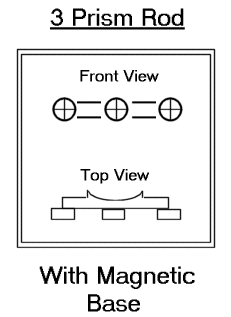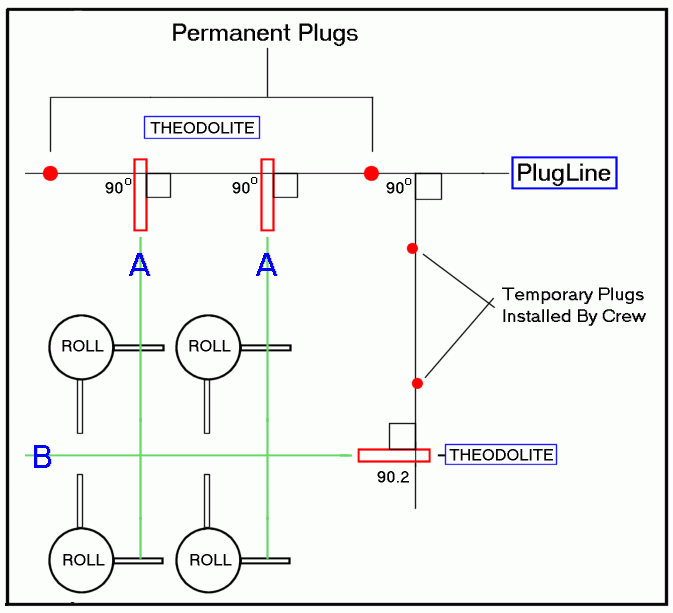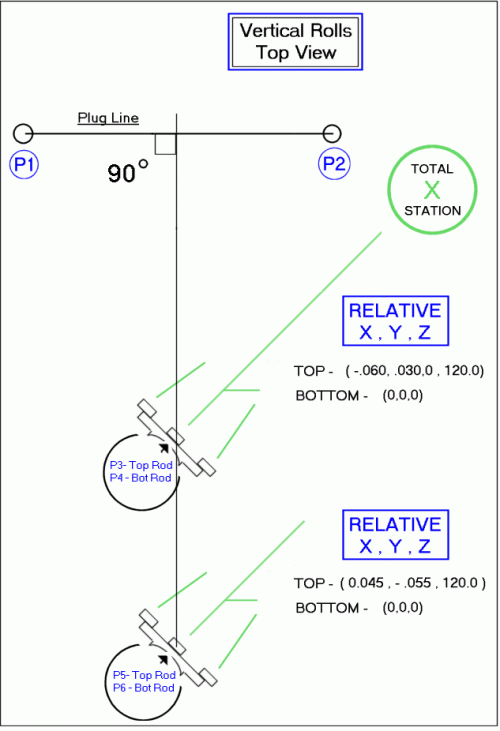Introduction
Here's a few thoughts on a rough idea . Finding perfect center of cylindrical machine parts is never easy . With Prisms it's almost impossible . Typical surfaces such as horizontal press , felt or dryer rolls , are fairly easy when using a Whiteface scale . We use a magnetic block that keeps the Whiteface square and then we just align the edge of the scale with the T2 or N3's reticule . Simple .
Vertical rolls like the Rougher entry are not as easy . With a Whiteface and a T2 on a vertical roll , we would have to slide the magnetic block around and watch the graduations on the scale to determine exactly when the scale is perpendicular to our line of sight .
With a modern Total Station and typical prism it's not very easy , if even possible . Some prism holders are designed for Metrology but still do not provide the level of confidence we're used to with Whitefaces .
So maybe something in the nature of a '3 Prism Rod' could be the solution ?
Basic Design

The center prism would be the prism used for recording coordinates , but the outside 2 prisms would be used to 'perfectly place' that center prism . The Total Station would measure to the outer prisms and when they are both exactly the same distance away from the Station , then they would be presumed to be perfectly aligned .

Field Usage
So , in the diagram above , we would set up a Total Station in front of this vertical roll and first , align the upper & lower '3 Prism Rods' and then measure to the center prism of each rod . The resulting coordinates would tell us exactly how much the roll was out of alignment .
However , because it's a Total Station , the coordinate results would give us alignment on both X and Y vertical axes with one single shot . It would tell us if the Roll is leaning side-to-side quite easily , but also tell us if the Roll is leaning away from us , by using it's built-in Distomat (EDM) .
The Old Way
For the below example , using a Theodolite , we would have to set up twice . Once for each axis . Then once a single move is made by the M/W's , we would have to shoot it again . Of course we would use 2 Theodolites and 2 Stickmen if exact tolerances are required ( dream on ) , or if time is a factor .
#1
) - Once 'on the PlugLine' to determine if the 2 Rolls are square to the Plugline
and if they are also plumb .
#2
) - Then in front of the machine to see if the Rolls are plumb in the other vertical axis .
In the diagram below we see that B Is not a critical shot if there is only one set of vertical rolls , but if it's a series of vertical rolls that also have to be 'in-line' , then laying out for the B shot soon becomes an "adventure in layout"

Obviously , the deadly accurate 1 second gun of the T2 Theodolite goes down the tubes in a hurry on a typical setup like this . The initial 90 degree shot will be very good , but the B setup leaves too much room for error .
The reasoning behind the traditional setup that the Yankees have been using for decades quickly comes to light . Laying out temp plugs or Calibrated Scales in order to turn a 90 , and then turn another 90 is asking for trouble . Permanent plugs or benchmarks are the only safe way to use a T2 .
The reason the typical 'Yankee' setup does work is because all possible error resides in 'the Shooter's eye' . The collimating 'Scopes' that Yankees have traditionally used have allowed good shooters to turn 90 , then turn 90 , then turn 90 . Properly calibrated instruments will return deadly accurate results .
Possible 3 Prism Rod Method
The below diagram say's it all . Shoot the 2 plugs to setup the Total Station . Simple . No need to be anywhere special , just so long as we can see the Roll .
After we align the Bottom Rod using the Total Station , we shoot the center prism . Do the same for the Top Rod . The software inside the Nikon will tell us exactly what the X,Y,Z difference is . It can also tell us what the relative distance is between the 2 top prisms , or the 2 bottom prisms , or any point we shoot for that matter .
That's it . Done ! If required we can set the Nikon to do 'Continuous Measuring' and watch as the M/W's move the bearing housing .

That's about it really . Of course the bracket could be modified to work well for horizontal rolls too . It could also be used to shoot floors accurately . Ton's of uses .
It would have to be machined precisely and calibrated on a regular basis too . Something like this appears to be sorely needed for any kind of accurate Total Station work involving rolls . Other ideas are also needed for simple shots using machined surfaces . Lot's of potential for new kinds of prisms and new shooting methods too .
BFN